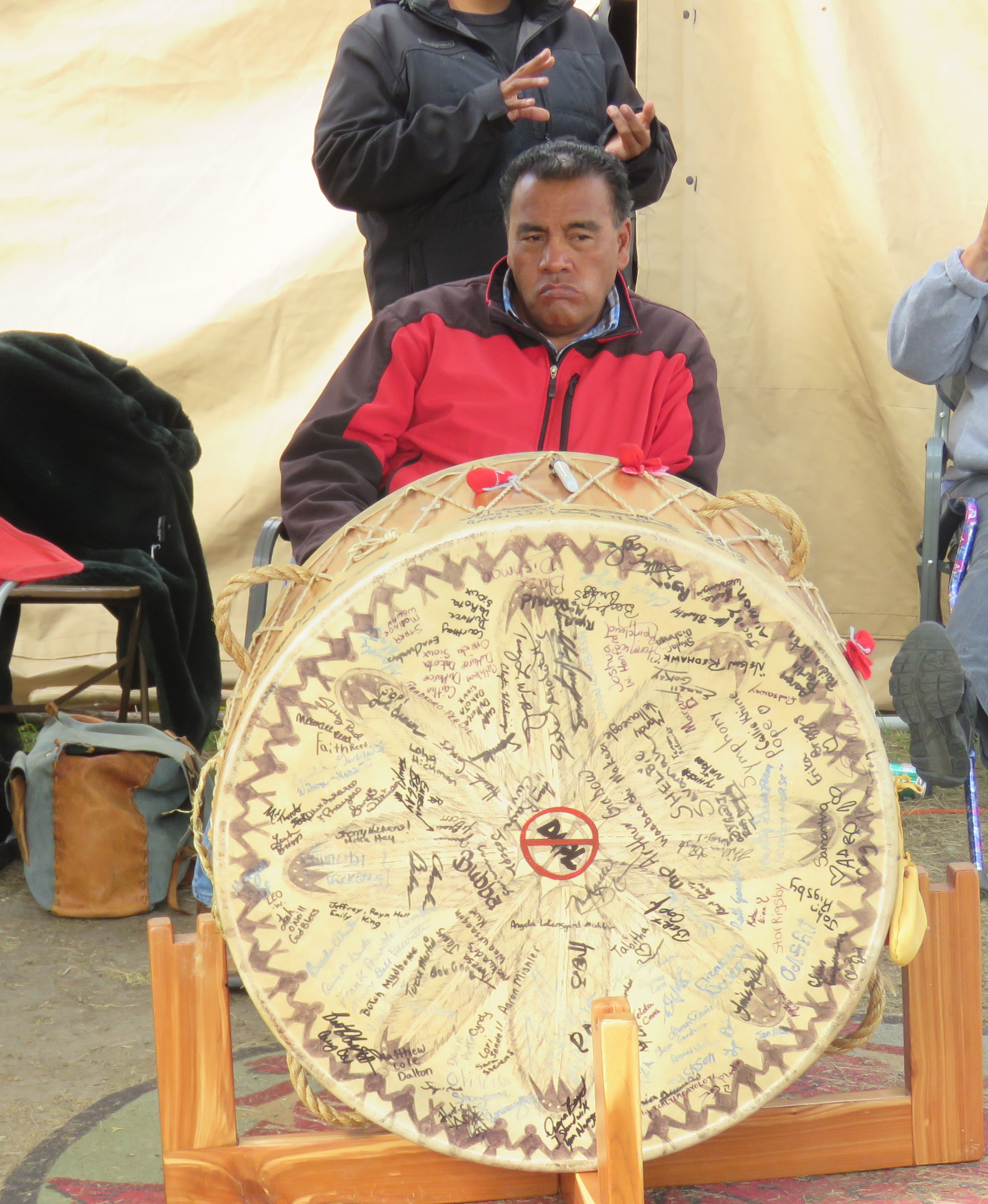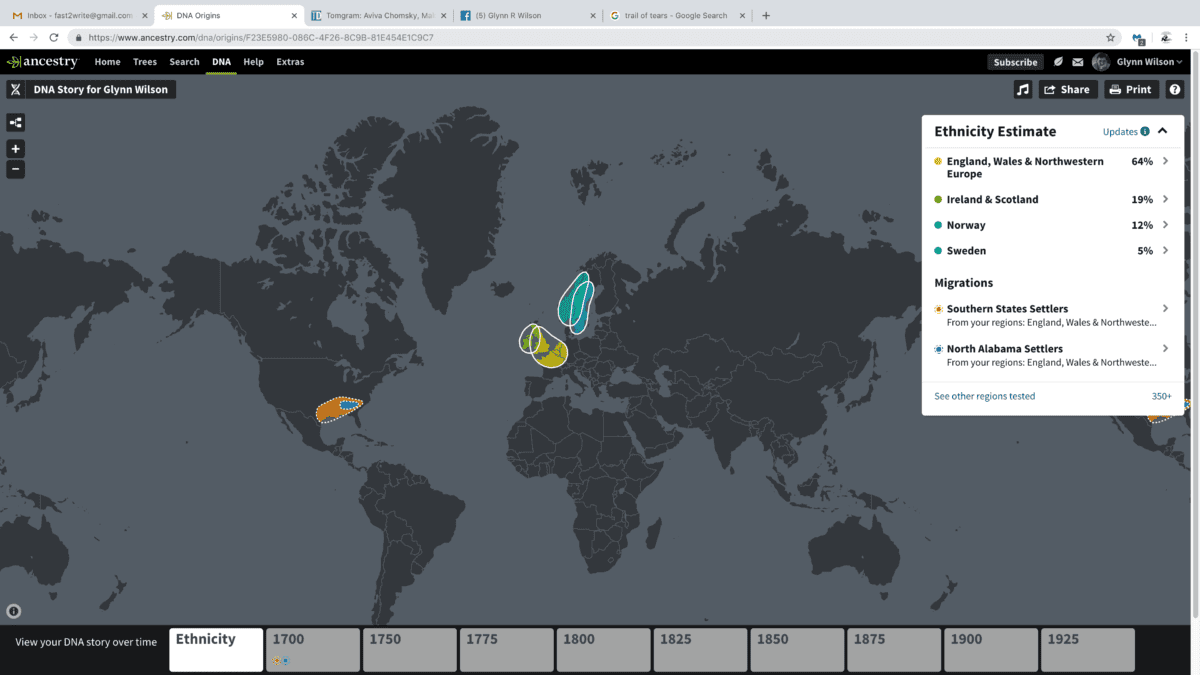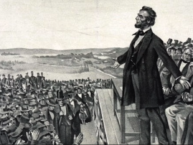
A member of the Standing Rock Sioux Tribe watches over a cerimonial drum donated by a tribe in Tennessee: Glynn Wilson
Editor’s Note by Glynn Wilson: Just this week I had time and thought to log back on to my account at Ancestry.com, to check on a report I received by email about six months ago. I had taken the $69 plunge to try Ancestry.com in an effort to confirm or deny my own suspicions about being part Cherokee. While I suspect that my grandmother on my father’s side of the family was Native American, maybe Creek, Muskogee or Cherokee, from St. Clair County, Alabama — which bordered part of the Cherokee Nation at one time along the Coosa River — if there were ever any family records concerning this they were destroyed around the time of the Trail of Tears in the 1830s.
Other research had given me clues, including the Love family name in the index of books listing all the known Cherokee names, specifically from St. Clair County. Her maiden name was Edith Love. Her look, height, hair color and the appearance of her family members that I knew as a child were consistent with what Cherokee Indians looked like. Not in dress, of course, or even speech. They had been assimilated through schools and churches and intermarriage after hiding in the caves from Andrew Jackson’s Army.
Earlier this year I signed up and paid the money to see what would turn up. I never wrote about it then because I was never able to really confirm or deny my theory. I suspected there was not enough of a DNA sample of Cherokee people in the Ancestry database for the first simple test to be accurate. It turns out I was right. This morning when I opened up the email inbox, Tom Engelhardt of TomDispatch.com had published a piece on this from Noam Chomsky’s daughter.
To add one person’s experience to this record, here’s my story in brief. The first report I got back from Ancestry — which I now know is based solely on samples from other people who have paid and submitted samples, no larger DNA database that might exist — here are the initial results.
It showed 81% from England, Wales and Northwestern Europe, 6% from Ireland and Scotland, 6% West Europe, and 1% from Finland, Scandinavia, Africa, Central Asia, and 1% Native American. Now we know that the sample size is so small for Native Americans because why in the world would they pay for and submit a sample? They know who they are.
To show how the results are distorted even more, in the newer report — updated when new samples come in from people who are willing to pay — they now say I am 64% from England, Wales and Northwestern Europe, 19% from Ireland and Scotland, 12 percent from Norway and 5% from Sweden. They show that both sides of my European family migrated to the region that would become the Southern States of America prior to 1750. Obliterated in the new rounded estimates are most significantly Native American and African. Everybody has African DNA. We all came from there originally. Any accurate estimate would keep that 1% dot.
It does include some documents now, which might be of use in genealogy research. It’s just not much help in documenting Native American ancestry. Clearly there is not enough of a sample to separate Cherokee from Choctaw, Chickasaw or Creek, or Seminole or any other tribe for that matter. This is pretty useless for that purpose. We also know that intermarriage with French trappers had started well before the English and Irish migrated here. I can only take some heart from the first report that showed 1% Native American. The gene is there. It would just take a more sophisticated test from a larger database of DNA samples to show it.
And even if it did, here’s the thing. We are all 99.9 percent DNA matches. We are arguing here about a fraction of .1 percent. Your DNA is not what makes you who you are. Your culture does. In that, place is important. Keep that in mind and read this excellent essay on the subject. Also keep in mind that Ancestry.com is a capitalist institution, which exists to make money by titillating those who want to believe they are descendants of great European royal family kings and queens.
By Aviva Chomsky –
Amid the barrage of racist, anti-immigrant, and other attacks launched by President Trump and his administration in recent months, a series of little noted steps have threatened Native American land rights and sovereignty. Such attacks have focused on tribal sovereignty, the Indian Child Welfare Act (ICWA), and the voting rights of Native Americans, and they have come from Washington, the courts, and a state legislature. What they share is a single conceptual framework: the idea that the long history that has shaped U.S.-Native American relations has no relevance to today’s realities.
Meanwhile, in an apparently unrelated event, Senator Elizabeth Warren, egged on by Donald Trump’s “Pocahontas†taunts and his mocking of her claims to native ancestry, triumphantly touted her DNA results to “prove†her Native American heritage. In turning to the burgeoning, for-profit DNA industry, however, she implicitly lent her progressive weight to claims about race and identity that go hand in hand with moves to undermine Native sovereignty.
The DNA industry has, in fact, found a way to profit from reviving and modernizing antiquated ideas about the biological origins of race and repackaging them in a cheerful, Disneyfied wrapping. While it’s true that the it’s-a-small-world-after-all multiculturalism of the new racial science rejects nineteenth-century scientific racism and Social Darwinism, it is offering a twenty-first-century version of pseudoscience that once again reduces race to a matter of genetics and origins. In the process, the corporate-promoted ancestry fad conveniently manages to erase the histories of conquest, colonization, and exploitation that created not just racial inequality but race itself as a crucial category in the modern world.
Today’s policy attacks on Native rights reproduce the same misunderstandings of race that the DNA industry is now so assiduously promoting. If Native Americans are reduced to little more than another genetic variation, there is no need for laws that acknowledge their land rights, treaty rights, and sovereignty. Nor must any thought be given to how to compensate for past harms, not to speak of the present ones that still structure their realities. A genetic understanding of race distorts such policies into unfair “privileges†offered to a racially defined group and so “discrimination†against non-Natives. This is precisely the logic behind recent rulings that have denied Mashpee tribal land rights in Massachusetts, dismantled the Indian Child Welfare Act (a law aimed at preventing the removal of Native American children from their families or communities), and attempted to suppress Native voting rights in North Dakota.
Profiting by Recreating Race
Let’s start by looking at how the ancestry industry contributes to, and profits from, a twenty-first-century reformulation of race. Companies like Ancestry.com and 23andMe lure customers into donating their DNA and a hefty sum of money in exchange for detailed reports claiming to reveal the exact geographical origins of their ancestors going back multiple generations. “Who do you think you are?†asks Ancestry.com, typically enough. The answer, the company promises, lies in your genes.
Such businesses eschew the actual term “race†in their literature. They claim instead that DNA reveals “ancestry composition†and “ethnicity.†In the process, however, they turn ethnicity, a term once explicitly meant to describe culture and identity, into something that can be measured in the genes. They conflate ethnicity with geography, and geography with genetic markers. Perhaps you won’t be surprised to learn that the “ethnicities†they identify bear an eerie resemblance to the “races†identified by European scientific racist thinking a century ago. They then produce scientific-looking “reports†that contain purportedly exact percentages linking consumers to places as specific as “Sardinia†or as broad as “East Asia.â€
At their most benign, these reports have become the equivalent of a contemporary parlor game, especially for white Americans who make up the vast majority of the participants. But there is a sinister undertone to it all, reviving as it does a long-discredited pseudoscientific basis for racism: the notion that race, ethnicity, and ancestry are revealed in the genes and the blood, and passed down inexorably, even if invisibly, from generation to generation. Behind this lies the assumption that those genes (or variations) originate within clearly defined national or geographic borders and that they reveal something meaningful about who we are — something otherwise invisible. In this way, race and ethnicity are separated from and elevated above experience, culture, and history.
Is There Any Science Behind It?
Although all humans share 99.9% of our DNA, there are some markers that exhibit variations. It’s these markers that the testers study, relying on the fact that certain variations are more (or less) common in different geographical areas. As law and sociology professor Dorothy Roberts puts it, “No sooner had the Human Genome Project determined that human beings are 99.9% alike than many scientists shifted their focus from human genetic commonality to the 0.1% of human genetic difference. This difference is increasingly seen as encompassing race.â€
Ancestry tests rely on a fundamental — and racialized — misunderstanding of how ancestry works. The popular assumption is that each of us contains discrete and measurable percentages of the “blood†and DNA of our two biological parents, four grandparents, eight great-grandparents, sixteen great-great-grandparents, and so on, and that this ancestral line can be traced back hundreds of years in a meaningful way. It can’t. As science journalist Carl Zimmer explains, “DNA is not a liquid that can be broken down into microscopic drops… We inherit about a quarter of our DNA from each grandparent — but only on average… If you pick one of your ancestors from 10 generations back, the odds are around 50% that you carry any DNA from him or her. The odds get even worse beyond that.â€
In reality, such testing does not tell us much about our ancestors. That’s partly because of the way DNA is passed down through the generations and partly because there exists no database of ancestral DNA. Instead, the companies compare your DNA to that of other contemporary humans who have paid them to take the test. Then they compare your particular variations to patterns of geographical and ethnic distribution of such variations in today’s world — and use secret algorithms to assign purportedly precise ancestral percentages to them.
So is there really a Sardinian or East Asian gene or genetic variation? Of course not. If there is one fact that we know about human history, it’s that ours is a history of migrations. We all originated in East Africa and populated the planet through ongoing migrations and interactions. None of this has ended (and, in fact, thanks to climate change, it will only increase). Cultures, ethnicities, and settlements can’t be frozen in time. The only thing that is constant is change. The peoples who reside in today’s Sardinia or East Asia are a snapshot that captures only a moment in a history of motion. The DNA industry’s claims about ancestry award that moment a false sense of permanence.
While whites of European ancestry seem enthralled with the implications of this new racial science, few Native Americans have chosen to donate to such databases. Centuries of abuse at the hands of colonial researchers who made their careers on Native ancestral remains, cultural artifacts, and languages have generated a widespread skepticism toward the notion of offering genetic material for the good of “science.†In fact, when it comes to one DNA testing outfit, 23andMe, all of the countries included in its lists of the geographical origins of those who have contributed to its “Native American†database are in Latin America and the Caribbean. “In North America,†the company blandly explains, “Native American ancestry tends to be five or more generations back, so that little DNA evidence of this heritage remains.†In other words, 23andMe claims DNA as conclusive proof of Native American identity, then uses it to write Native North Americans off the map altogether.
The Ancestry Industry and the Disappearing Indian
The ancestry industry, even while celebrating diverse origins and multiculturalism, has revived long-held ideas about purity and authenticity. For much of U.S. history, white colonizers argued that Native Americans would “vanish,†at least in part through biological dilution. New England’s native peoples were, for instance, systematically denied land rights and tribal status in the nineteenth century on the grounds that they were too racially mixed to be “authentic†Indians.
As historian Jean O’Brien has explained, “Insistence on ‘blood purity’ as a central criterion of ‘authentic’ Indianness reflected the scientific racism that prevailed in the nineteenth century. New England Indians had intermarried, including with African Americans, for many decades, and their failure to comply with non-Indian ideas about Indian phenotype strained the credence for their Indianness in New England minds.†The supposed “disappearance†of such Indians then justified the elimination of any rights that they might have had to land or sovereignty, the elimination of which, in a form of circular reasoning, only confirmed their nonexistence as a people.
However, it was never phenotype or distant ancestry but, as O’Brien points out, “complex regional kinship networks that remained at the core of Indian identity in New England, despite the nearly complete Indian dispossession that English colonists accomplished… Even as Indians continued to reckon membership in their communities through the time-honored system of kinship, New Englanders invoked the myth of blood purity as identity in denying Indian persistence.â€
Such antiquated understandings of race as a biological or scientific category allowed whites to deny Indian existence — and now allow them to make biological claims about “Indian†identity. Until recently, such claims, as in Senator Warren’s case, rested on the murkiness of family tales. Today, the supposed ability of DNA companies to find genetic “proof†of such a background reinforces the idea that Indian identity is something measurable in the blood and sidesteps the historical basis for the legal recognition or protection of Indian rights.
The ancestry industry assumes that there is something meaningful about the supposed racial identity of one of hundreds or even thousands of an individual’s ancestors. It’s an idea that plays directly into the hands of right-wingers who are intent on attacking what they call “identity politics†— and the notion that “minorities†are becoming unduly privileged.
Indeed, white resentment flared at the suggestion that Senator Warren might have received some professional benefit from her claim to Native status. Despite an exhaustive investigation by the Boston Globe showing conclusively that she did not, the myth persists and has become an implicit part of Donald Trump’s mockery of her. In fact, any quick scan of statistics will confirm the ludicrousness of such a position. It should be obvious that being Native American (or Black, or Latino) in the United States confers far more risks than benefits. Native Americans suffer from higher rates of poverty, unemployment, infant mortality, and low birth weight, as well as lower educational levels and shorter life spans than do whites. These statistics are the result of hundreds of years of genocide, exclusion, and discrimination — not the presence or absence of specific genetic variations.
Reviving Race to Undermine Native Rights
Native rights, from sovereignty to acknowledgment of the conditions created by 500 years of colonial misrule, rest on an acceptance that race and identity are, in fact, the products of history. “Native Americans†came into being not through genes but through the historical processes of conquest and colonial rule, along with grudging and fragile acknowledgement of Native sovereignty. Native American nations are political and cultural entities, the products of history, not genes, and white people’s assertions about Native American ancestry and the DNA industry’s claim to be able to reveal such ancestry tend to run roughshod over this history.
Let’s look at three developments that have, over the past year, undermined the rights of Native Americans: the reversal of reservation status for Mashpee tribal lands in Massachusetts, the striking down of the Indian Child Welfare Act, and Republican attempts to suppress Native American votes in North Dakota. Each of these acts came from a different part of the government: the Bureau of Indian Affairs in the Department of the Interior, the courts, and North Dakota’s Republican-dominated state legislature. But all three rely on notions of identity that place race firmly in our genes rather than in our history. In the process, they deny the histories that turned the sovereign and autonomous peoples of North America before European colonists arrived in “the New World†into “Native Americans,†and imply that Native American historical rights are meaningless.
The Mashpee of Massachusetts finally achieved federal recognition and a grant of reservation land only in 2007, based on the fact that they “had existed as a distinct community since the 1620s.†In other words, federal recognition was based on a historical, not a racialized, understanding of ethnicity and identity. However, the tribe’s drive to build a casino on its newly acquired reservation in Taunton, Massachusetts, would promptly be challenged by local property-owners. Their lawsuit relied on a technicality: that, as they argued in court, reservation land could only be granted to tribes that had been federally recognized as of 1934. In fact, the Mashpee struggle for recognition had been repeatedly stymied by long-held notions that the Indians of Massachusetts were not “real†or “authentic†because of centuries of racial mixing. There was nothing new in this. The state’s nineteenth-century legislature prefigured just such a twenty-first-century backlash against recognition when it boasted that real Indians no longer existed in Massachusetts and that the state was poised to wipe out all such “distinctions of race and caste.â€
In September 2018, the Department of the Interior (to which the court assigned the ultimate decision) ruled against the Mashpees. Recently appointed Assistant Director of Indian Affairs Tara Sweeney, the first Native American to hold that position, “paved the way for a reservation to be taken out of trust for the first time since the termination era,†a 20-year period from the 1940s to the 1960s when the federal government attempted to “terminate†Native sovereignty entirely by dismantling reservations and removing Indians to urban areas to “assimilate†them. The new ruling could affect far more than the Mashpees. Some fear that, in the Trump years, the decision portends “a new termination era,†or even a possible “extermination era,†for the country’s Native Americans.
Meanwhile, on October 4th, a U.S. District Court struck down the Indian Child Welfare Act, or ICWA. This is a potentially devastating development as Congress passed that Act in 1978 to end the then-still-common practice of breaking up Native families by removing Indian children for adoption into white families. Such acts of removal date back to the earliest days of white settlement and over the centuries included various kinds of servitude and the founding of residential boarding schools for Indian children that were aimed at eliminating Native languages, cultures, and identities, while promoting “assimilation.†Indian child removal continued into the late twentieth century through a federally sponsored “Indian Adoption Project,†as well as the sending of a remarkable number of such children into the foster care system.
According to the ICWA, “An alarmingly high percentage of Indian families are broken up by the removal, often unwarranted, of their children from them by nontribal public and private agencies and that an alarmingly high percentage of such children are placed in non-Indian foster and adoptive homes and institutions.†States, it added, “have often failed to recognize the essential tribal relations of Indian people and the cultural and social standards prevailing in Indian communities and families.†The Act gave tribes primary jurisdiction over all child custody issues including foster placements and the termination of parental rights, requiring for the first time that priority be placed on keeping Native children with their parents, kin, or at least within the tribe.
The ICWA said nothing about race or ancestry. Instead, it recognized “Indian†as a political status, while acknowledging semi-sovereign collective rights. It was based on the Constitution’s implicit acknowledgement of Indian sovereignty and land rights and the assignment to the Federal government of relations with Indian tribes. The District Court’s ICWA decision trampled on the collective political rights of Indian tribes by maintaining that the act discriminated against non-Native families in limiting their right to foster or adopt Native children. That rationale, like the rationale behind the Mashpee decision, directly attacks the cultural and historical acknowledgement of Native sovereignty.
Superficially, the assault on Native voting rights may appear conceptually unrelated to the Mashpee and ICWA decisions. North Dakota is one of many primarily Republican-controlled states to take advantage of a 2013 Supreme Court ruling eliminating key protections of the Voting Rights Act to make registration and voting more difficult, especially for likely Democratic voters including the poor and people of color. After numerous challenges, a North Dakota law requiring prospective voters to provide a street address was finally upheld by a Supreme Court ruling in October 2018. The problem is this: thousands of rural Native Americans, on or off that state’s reservations, lack street addresses because their streets have no names, their homes no numbers. Native Americans are also disproportionately homeless.
In the North Dakota case, Native Americans are fighting for a right of American citizens — the right to vote — whereas the Mashpee and ICWA cases involve fights to defend Native sovereignty. The new voting law invoked equality and individual rights, even as it actually focused on restricting the rights of Native Americans. Underpinning such restrictions was a convenient denial by those Republicans that the country’s history had, in fact, created conditions that were decidedly unequal. (Thanks to a massive and expensive local effort to defend their right to vote, however, North Dakota’s Native Americans showed up in record numbers in the 2018 midterm election.)
These three political developments downplay Native American identity, sovereignty, and rights, while denying, implicitly or explicitly, that history created today’s realities of racial inequality. The use of DNA tests to claim “Native American†genes or blood trivializes this same history.
The recognition of tribal sovereignty at least acknowledges that the existence of the United States is predicated on its imposition of an unwanted, foreign political entity on Native lands. The concept of tribal sovereignty has given Native Americans a legal and collective basis for fighting for a different way of thinking about history, rights, and nationhood. Attempts to reduce Native American identity to a race that can be identified by a gene (or a genetic variation) do violence to our history and justify ongoing violations of Native rights.
Senator Elizabeth Warren had every right to set the record straight regarding false accusations about her employment history. She should, however, rethink the implications of letting either Donald Trump or the ancestry industry define what it means to be Native American.
—
Aviva Chomsky is professor of history and coordinator of Latin American studies at Salem State University in Massachusetts. Her most recent book is Undocumented: How Immigration Became Illegal. Originally published by TomDispatch.com, associated with the Nation Institute. Republished here with permission. Copyright © 2018 Aviva Chomsky.
















St. Clair County, AL was part of the Creek Nation until 1817. It was never part of the Cherokee Nation. For that matter, the Cherokees’ presence in Alabama was very brief and not that significant. They were given the Chickasaw lands in NE Alabama in the 1794 treaty and forced to leave in 1838.
Many federally-recognized Cherokees have no or a minuscule amount of Native American DNA. It is far more common for self-described Cherokees in Alabama and North Georgia to actually be descended from Sephardic Jewish settlers, who lived in the Southern Appalachians in the 1600s and early 1700s.
Interesting suppositions. Care to offer supporting links? Might make a useful archive.
Did you not read the article? It’s not about how much “Cherokee DNA” the federally recognized Cherokee have, its about how they have cultural and genealogically continuity from the first Euro-Cherokee contact, until now, and not about some fake Cherokee heritage groups who think they are Hebrew Israelites!
Some information here. St. Clair County bordered what was the Cherokee Nation along the Coosa River.
Alabama Land Cessions Map
https://www.accessgenealogy.com/alabama/alabama-land-cessions-map.htm